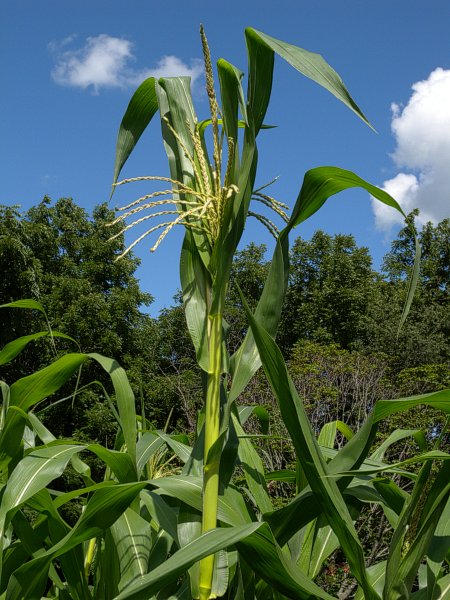
This grass produces a single terminal staminate inflorescence (called the 'tassel') and several axillary pistillate inflorescences (called the 'ears'). The staminate inflorescence is typically about 1' long and a little less across, consisting of a panicle of spike-like racemes; it is greenish yellow during the blooming period. This panicle has a straight central rachis and several lateral racemes originating from this rachis that are ascending to arching. The central axis is covered with about 4 rows of staminate spikelets along most of its length, while the lateral racemes are covered with about 2 rows of staminate spikelets. The staminate spikelets are about 9-14 mm. in length, ellipsoid-lanceoloid in shape, and slightly flattened. Each staminate spikelet consists of a pair of outer glumes, a pair of membranous lemmas, and a pair of staminate florets that are separated by membranous paleae. Each staminate floret has 3 anthers that are yellow, elongated in shape, and relatively large. During the period of bloom, the axillary pistillate inflorescences are 6-12" long, 1-3½" across, cylindrical-lanceoloid in shape, and semi-erect; they occur on short stout peduncles from the axils of the lower-middle to upper leaves, where they are solitary. Each pistillate inflorescence is mostly covered by modified sheaths (called the 'husks') that are light green, glabrous (or nearly so), and longitudinally wrinkled; some of these sheaths may have diminutive blades that are medium green. The central rachis of each pistillate inflorescence (called the 'cob') is thick, terete, and slightly woody; surrounding this rachis are 8-32 rows of pistillate spikelets that are densely bunched together.

Each pistillate spikelet has one fertile floret and one infertile (aborted) floret; the pistillate spikelet has a pair of short fleshy glumes, a short membranous lemma, a short membranous palea, and an ovary with a pair of styles. The two styles are fused together, except near their tips; they are long, silky, and filamentous. The filamentous styles are exerted from the tip of the pistillate inflorescence and stigmatic along their sides. Collectively, these styles are referred to as the 'silk' of the ear (pistillate inflorescence). The blooming period occurs from mid- to late summer, lasting about 1-2 weeks for a colony of plants. The florets are cross-pollinated by the wind. While some limited self-pollination can occur, mature grains (called 'kernels') are more abundant when cross-pollination from neighboring plants occur. After the blooming period, the pistillate inflorescences (ears of corn) enlarge in size slightly and the pistillate florets are replaced by kernels (seeds) that mature during the autumn. Mature kernels are either ovoid in shape, or they are obovoid and somewhat flattened in shape; they are exerted beyond the glumes and hard-coated. The kernels on an ear of corn can be yellow, white, red, purplish-blue, or some combination of these colors (as occurs in 'Indian Corn'), although they are mostly typically yellow. Both ears of corn and their kernels are resistant to disarticulation. The root system is coarsely fibrous. Support roots often develop from the lower nodes of the culm. This grass reproduces by reseeding itself.
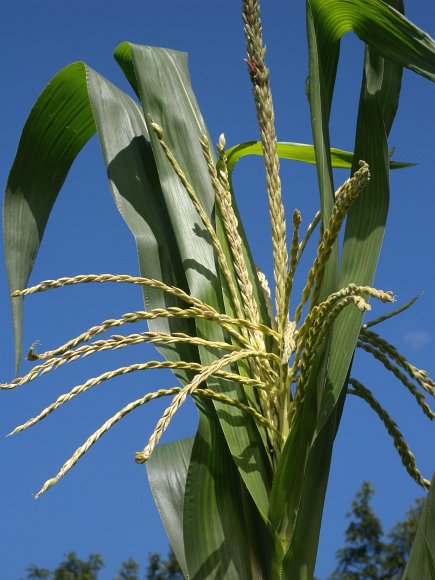
Cultivation: Cultivated corn usually prefers full sun, mesic levels of moisture, and fertile loamy soil. Because of its C4 metabolism, cultivated corn grows best in warm to slightly hot summer weather. Flooded conditions, severe drought, and infertile soil are detrimental to the growth and development of this grass. Because its pollen is rather heavy, more mature kernels on ears of corn are produced when corn plants are adjacent to each other in relatively large blocks. This arrangement also reduces the likelihood that individual plants will topple over in high winds. The size of individual plants can be highly variable. There are many different kinds of cultivated corn that can vary somewhat in their growing requirements.
Range & Habitat: Cultivated corn has probably naturalized, at one time or another, in every county of Illinois, although it never persists outside of cultivation. Current collections of naturalized plants underestimate the ubiquitousness of this species (see Distribution Map). The ancestor of modern cultivated corn probably originated from southern Mexico. From there, older strains of cultivated corn spread northward to include the southern half of North America (including Illinois) prior to the period of European settlement. Current habitats of modern naturalized plants include cropland, fallow fields, vacant lots, roadsides, areas along railroads, areas around grain elevators, and areas around bird feeders. Cultivated corn is a major agricultural crop in Illinois, and it is occasionally cultivated as a source of food for wildlife in natural areas. This grass prefers sunny habitats with a history of disturbance where the topsoil has been exposed.
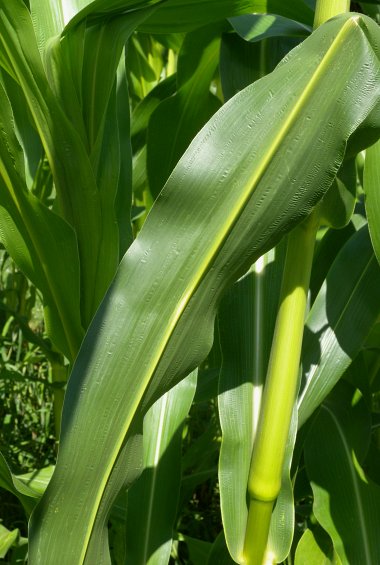
Faunal Associations: Because cultivated corn is a major agricultural crop, there is considerable knowledge about the insects that feed on it. Examples of such species include the Corn Flea Beetle (Chaetocnema pulicaria), Northern Corn Rootworm (Diabrotica barberi), Southern Corn Leaf Beetle (Myochrous denticollis), LeConte's Seed Corn Beetle (Stenolophus lecontei), Southern Corn Billbug (Sphenophorus callosus), Maize Billbug (Sphenophorus maidis), Corn Blotch Leafminer (Agromyza parvicornis), Seed Corn Maggot (Delia platura), Common Chinch Bug (Blissus leucopterus leucopterus), Red-shouldered Stink Bug (Thyanta custator accerra), Corn Leaf Aphid (Rhopalosiphum maidis), Corn Earworm Moth (Helicoverpa zea), European Corn Borer Moth (Ostrinia nubilalis), Eufala Skipper (Lerodea eufala), Two-striped Grasshopper (Melanoplus bivittatus), Migratory Grasshopper (Melanoplus sanguinipes), and Eastern Grass Thrips (Anaphothrips obscura). The Insect Table and Moth Table display more complete lists of these species.
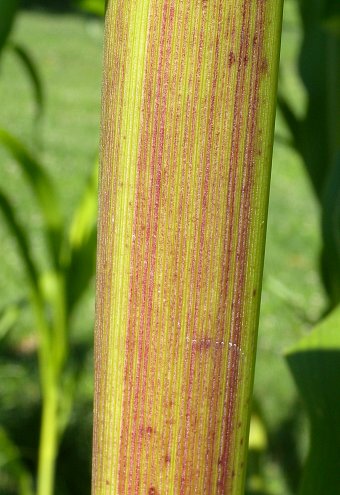
Cultivated corn is also an important source of food for many kinds of vertebrate wildlife. The kernels are eaten by many species of ducks, upland gamebirds, songbirds, and other birds. This includes such species as the Sandhill Crane, Canada Goose, Mallard, Northern Pintail, Greater Prairie Chicken, Ring-necked Pheasant, Redwing Blackbird, American Crow, Common Grackle, House Sparrow, Lincoln Sparrow, and Red-headed Woodpecker. The seeds were also eaten by two extinct birds, the Passenger Pigeon and Carolina Parakeet. The Bird Table has a more complete list of these species. Some mammals also rely on cultivated corn as a source of food. The kernels are eaten by the Raccoon, Opossum, Fox Squirrel, Gray Squirrel, House Mouse, and Prairie Deer Mouse, while the foliage of either seedlings or more more mature plants is eaten by the White-tailed Deer, Groundhog, and domesticated cattle (Martin et al., 1951/1961; Whitaker, 1966). There are also records of the Painted Turtle (Chrysemys picta) and Spiny Softshell (Trionyx spiniferus) using corn as a minor food source (Ernst et al., 1994).
Photographic Location: A corn field at Meadowbrook Park in Urbana, Illinois.
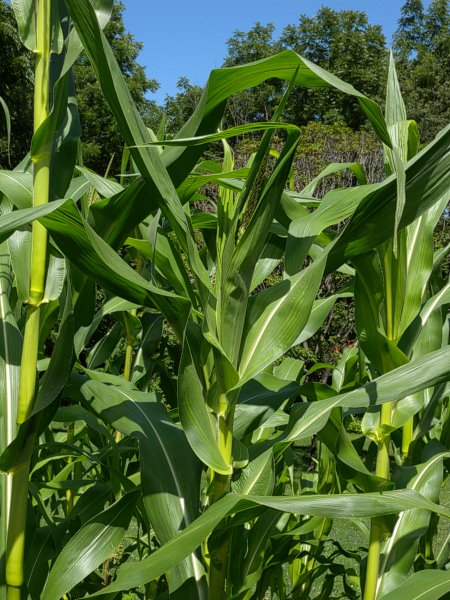
Comments: Cultivated corn (Zea mays) has a very distinctive appearance, making it easy to identify. There are other corn species (Zea spp.) that are found in southern Mexico and other areas of Central America, but they are not normally found in Illinois as either wild or cultivated plants. These other corn species have much smaller corn ears than cultivated corn, and the glumes of their corn ears usually enclose the kernels (pod corn). The closest relative to cultivated corn in Illinois is the native Eastern Gama Grass (Tripsacum dactyloides). This latter grass produces large leaves that have some resemblance to those of cultivated corn, and there are some structural similarities in their inflorescences. However, Eastern Gama Grass differs by producing both male (staminate) and female (pistillate) flowers on the same terminal inflorescence, while cultivated corn produces a terminal male inflorescence (the tassel) and axillary female inflorescences (corn ears) that are separated from each other. There are several kinds of cultivated corn that are used to produce field corn, sweet corn, popcorn, corn flour, and ornamental corn. Cultivated corn has been used to make such products as corn chips, tortillas, tostados, corn meal, breakfast cereal, corn syrup, corn oil, distilled liquor, animal feed, bird seed, and ethyl alcohol in gasoline. Another common name of cultivated corn is maize.